More money to perpetuate a broken system is why I urge you to vote no on Prop D. More funding without reform will continue the damage our transportation policies and spending have done to our communities big and small.
Prop D would increase the fuel tax by 2.5 cents a year for four years, totaling 10 cents. Per the Missouri Constitution (Amendment 3 passed in Nov 2004) the revenue raised by the current fuel tax may only be spent on state and local roads and bridges. Vehicle taxes and fees can only pay the costs of collecting the tax, the Missouri State Highway Patrol, road debt, and state roads and bridges. Prop D revenue can go to the MSHP. Whether the new revenue makes up for a shortfall in vehicle taxes and fees to pay for the MSHP or most of Prop D revenue after allocation to counties and cities will go to the MSHP thus freeing up the vehicle tax and fee revenue for roads and bridges, unless the MSHP’s budget is increased substantially, the net affect is more money for roads and bridges. It also creates the Emergency State Freight Bottleneck Fund. More details at Ballotpedia.
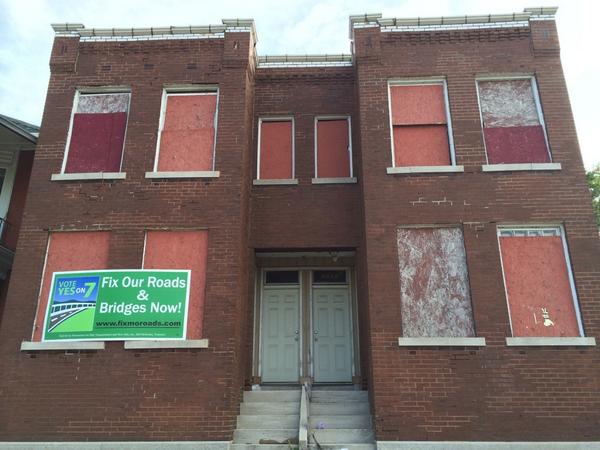
- Nextstl – Vote No On Amendment 7 – August 5th
- Nextstl – Vote NO on 7: Continue the Conversation on Transportation Priorities
- Nextstl – Transportation Sales Tax Loses Big: Urban Vote Leads 18% Defeat
I’ll concede this is better than the rejected 0.75% sales tax proposed in 2014. It made no sense that someone buying a pair of shoes should pay for roads while someone driving across the state wouldn’t pay any more. A fuel tax increase will also capture revenue from non-Missouri residents buying fuel in the state.
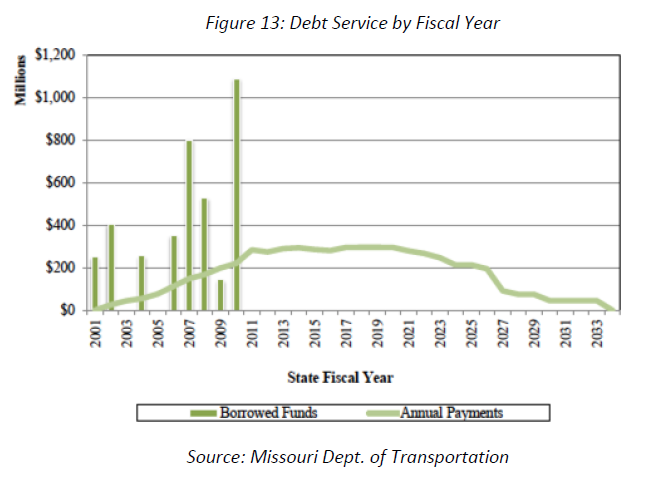
It’s also better than issuing debt. Debt service on road bonds cost $280M in 2016. Instead of raising the fuel tax in the past we taxed the future by issuing bonds last decade. Paying it back plus interest and fees is crowding out current spending. And it’s better than shifting general revenue or other accounting gimmicks which the Federal government is doing instead of raising its fuel tax (unchanged since 1993). Another concern is what the Missouri Legislature might do if this fails. They could shift general revenue to roads or cut tax credit programs (some which lessen the pressure to build more infrastructure like the Historic Tax Credits), or who knows.
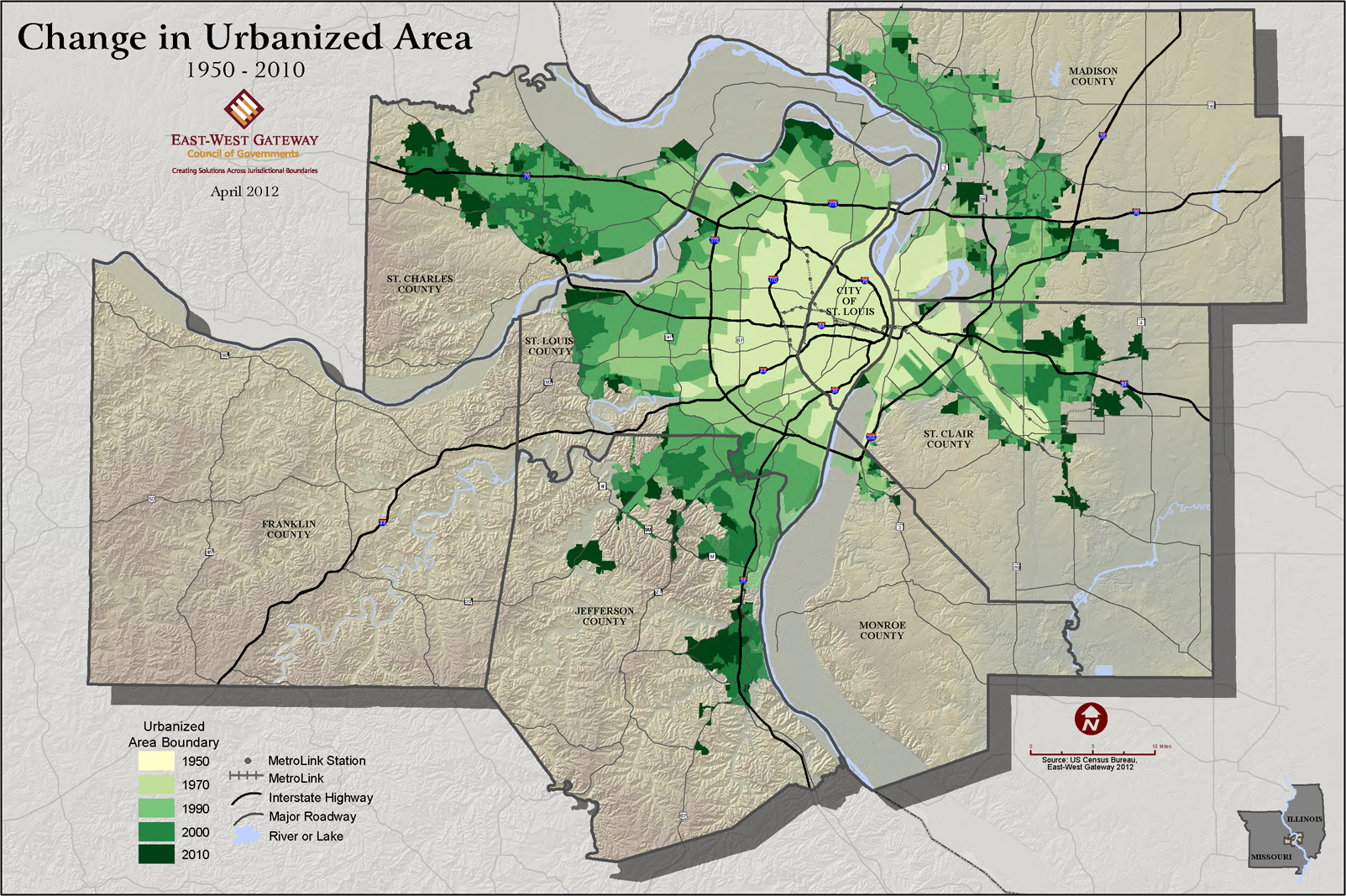
No Reform
This proposition contains no reforms to mitigate the damage our current approach does nor avoids returning to the same state we find ourselves in now. We’ve seen how the system has spread out our communities, undermining already built places, depressing property values, driving up costs both to the public and private sectors. Necessitating more driving and rendering less and less practical other cheaper options has crowded out spending on other household needs. We’ve made ourselves house poor as a community wherein the cost to maintain more and more infrastructure per household prevents us from doing other things. Worse much of the wealth spent on fuel, vehicles, etc leaves towns, regions, and the state. Our current system has encouraged, even mandated one mode of transportation and more vehicle miles traveled to lead one’s life.
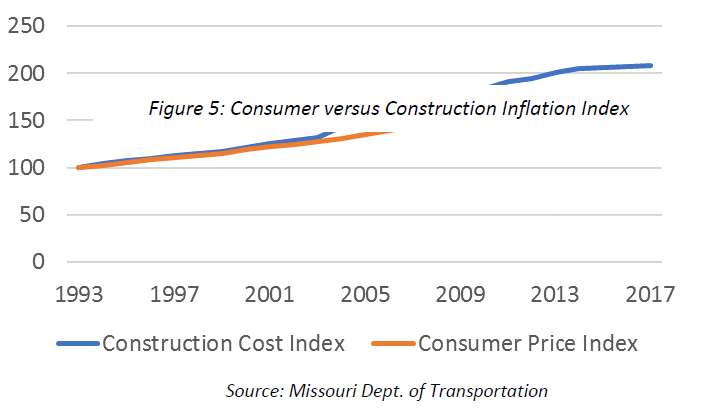
No Accounting for Inflation
The last time the state fuel tax was raised in 1996 indexing the tax to account for inflation wasn’t included. Over time that 17 cents has been eroded. Raising it to 27 cents doesn’t even make up for inflation to 2018 dollars (17 in 1996 is 27.8 today) let alone when fully implemented in 2022. That’s the consumer price index. The construction price index is up 109% 1993-2017 vs 68% for the consumer price index. This proposal doesn’t include accounting for inflation either, so it will be eroded over time again.While drivers have enjoyed fuel tax cuts over the years via inflation, St. Louis transit riders have not.
- Nextstl – Gas Tax Cut Again in Missouri
Antiquated Local Allocation Formula
Per state statute 30% of the revenue from fuel taxes goes to counties and cities, 15%/15%. Does the allocation make sense today? Should need or return on investment be considered? Do the restrictions on the money make sense today? The city allocation is based on population, and the county allocation based on miles of county roads and land valuation outside of incorporated areas. Here is a list of the predicted allocation courtesy of safermo.com, the main proponent of the proposition. For cities it amounts $15.73 per resident per year when fully implemented. Note the disconnects. A city that sees more than average use from nonresidents is shortchanged. A county with lots of residents in unincorporated areas is shortchanged. St. Louis County has over 320,000 residents in unincorporated areas. That’s over $5M missed out on under this tax increase (and $8.5M under the current tax). Though if St. Louis County fully incorporated, and the munis got the per person city allocation it would eat up the county allocation unless it got a spelled-out allocation from the county portion like St. Louis City does.

Build, Build, Build
If you view this tax increase as making government bigger, the gov’t was already made bigger by the road building- now the bill is coming due. Since the last fuel tax increase in 1996, Missouri has added 7,910 lane-miles to the state system (FHWA Report 1996. 2016). Absent strong feedback mechanisms and prioritizing return on investment, we’ve built more and more. I understand the morality of providing access and not cutting people off from the outside world, but building 4-lane roads and luxury features like flyovers without considering whether the economic activity they enable can pay for them is beyond meeting that basic principle. We’ve added liabilities and under-prioritized maintenance, digging the hole bigger. Perhaps given the magnitude of the maintenance backlog, the vast majority of funding will go to maintenance, but I’m skeptical given that even in these tight times, MoDOT has undertaken expansion projects like a flyover at 141 and I-44 and an additional lane on I-64 in west St. Louis County. Prop D makes no provision to raise the bar whether or not a new or expanded road project happens.
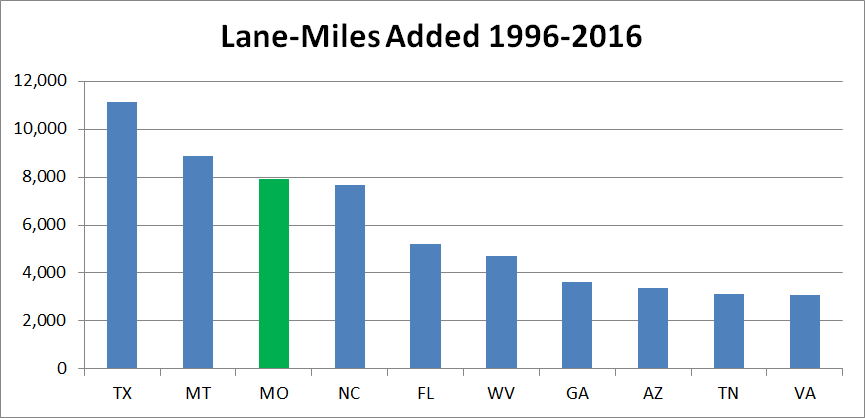
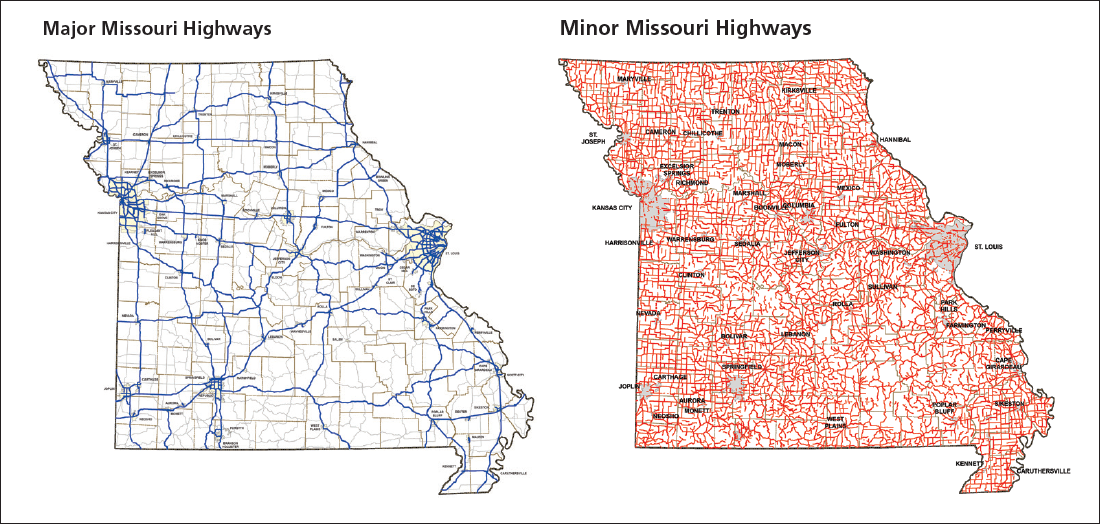
Right-Sizing
Proponents like the Governor cite that Missouri has the 7th largest state road system in the country as justification for more funding. It begs the question- why do we have the 7th largest system? Does it make sense today? Perhaps some roads should be shrunk or degraded considering how much they’re used and how much economic activity they enable. Maybe some or all of the minor roads should be bequeathed to counties to tax, spend, and maintain (or not) as they see fit. The state could be a partner in that in expertise and (small %) matching funding, but with the locality more on the hook maybe that luxury flyover doesn’t make as much sense considering the local capacity to build and maintain over the long-term.
- Curbed – Omaha returns to gravel roads to cut maintenance costs
- Wired – Cash-Strapped Towns Are Un-Paving Roads They Can’t Afford To Fix
- WPR – In Small Wisconsin Towns, Paved Roads Return To Gravel
No Accounting for Long-term Liabilities
The predictable maintenance and replacement costs of our road system weren’t planned for. It’s analogous to a pension system where nothing has been saved yet promises made. We’re aware of how daunting our underfunded pension systems are. Our infrastructure promises (not just roads and bridges) are of the same magnitude and should garner commensurate concern. Consider had money been set aside over the years in an endowment to cover those predictable costs. If this had been done in the past we’d be in better financial shape today though it would have meant building less or taxing more, neither desirable, but more responsible than leveraging the asset by the contemporary while kicking the can on the liability to the future. I-70 needs to be rebuilt? No problem the endowment has built up (plus investment earnings) over the years to cover it.
Weak Feedback Mechanisms
Weak feedback mechanisms have lead to our over-built and over-used system. Our roads are under-priced thus they are used more than they would be. We build more; it induces more demand, repeat. The fuel tax helps, though fuel economy doesn’t scale with vehicle weight which leads to a subsidy for heavy vehicles. An 80,000 pound vehicle might consume 5 times the fuel per mile as a 4,000 pound one, but it does hundreds of times the damage. In either case if the prices paid don’t cover the costs, that’s insolvency. Tolls would provide more direct feedback. The idea has come up in the effort to rebuild I-70.
Entitlement Program or Platform for Economic Activity
Some of both of course. A good road moves people and goods between productive places. A good street is a platform for building wealth for adjacent land uses. When designed well they both provide great returns. Where we get into trouble is trying to do both. The in between, the stroad, fails at both. Adjacent land uses aren’t productive enough to cover the costs of the infrastructure serving it due to lots of land needed to provide enough off street parking for the near 100% of patrons who arrive by car. The spreading-out makes our communities more fragile, more house-poor. Moving a lot of people and goods is stymied by too many points of conflict and intersections. These environments are unsafe to boot. MoDOT built and maintains a lot of the stroads in communities across the state.
As I said above the value of providing access to people I think is important to the vast majority of Missourians. On the other hand we’ve fostered with much government action the expectation that longer and longer trip distances within places should come with no consequence even though driving further to the same (in the sense of economic activity) job, shopping, entertainment, etc comes at a high price (economic, physical and mental health, environmental, etc) for everyone. The cost to build and maintain the infrastructure to enable it, and the wealth leaving the community and state is a drag on the state and local economy. Despite those negatives enabling long local trips (by car) is a concern for the state. So many are now dependent on it because our land use and transportation infrastructure choices leave no other practical options.
We created cars to increase our convenience, now every menial movement requires an inconvenient auto trip. – Charles Marohn of Strong Towns
- The Economist – Commuting makes you unhappy
- Vox – Long commutes make you fat, tired, and miserable
Poison Pill
There’s a poison pill in Prop D. The Emergency State Freight Bottleneck Fund would be a mechanism to shift general revenue to pay for road and bridge building thus further mispricing their use. Projects must met all of the following conditions:
- the project is a road improvement project with an estimated construction cost of at least $50M
- the project is required to alleviate a delay of 20 minutes or more during peak traffic hours that impacts freight and the distribution of goods
- the project is required to reduce serious motor vehicle crashes causing fatalities or disabilities
- the project is featured on the 2014 state freight plan. Project List in Appendix G Page 401
- the project is set to receive 35% of funds from sources besides the state road fund and general fund revenue.
Tough to tell which projects would met all those criteria, but there’s certainly plenty above $50M in the 2014 Freight Plan list including billions to rebuild I-70 and I-44.
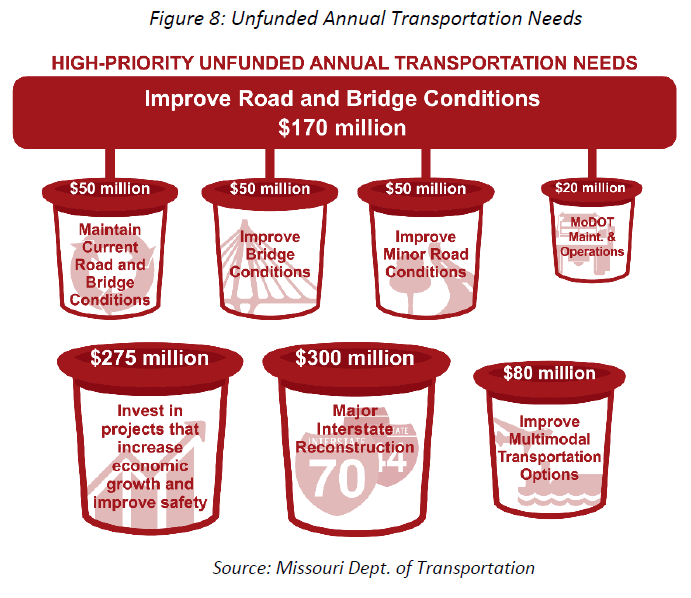
It’s Not Enough
When fully implemented the Prop D tax increase ($288M for the road fund) doesn’t cover the needs identified by the 21st Century Missouri Transportation System Task Force of $825M annually (Report). Whether that amount is truly needed is debatable of course (I doubt shrinking any part of the system or changes to land use policy so we get more out of what we have already built was considered), but given the wide margin made wider by inflation this is quite inadequate. The Federal matching funds may make up some of the gap, though the Federal situation isn’t any better – Strong Towns – Some Perspective on the Gas Tax. A bigger tax increase would probably be less likely to pass, so if Prop D passes we’ll be paying some more but not enough more. With or without Prop D, without reform the disconnect between what we’re paying and our expectations will continue.
